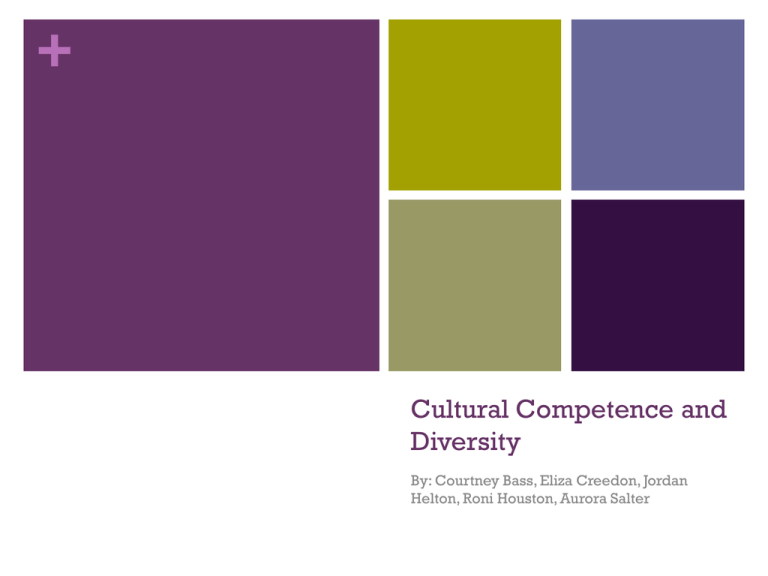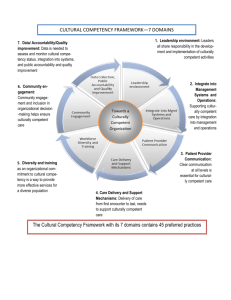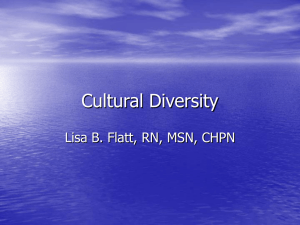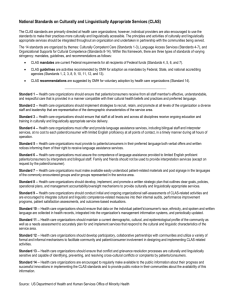File
advertisement

+ Cultural Competence and Diversity By: Courtney Bass, Eliza Creedon, Jordan Helton, Roni Houston, Aurora Salter + Agenda Objectives: Identify barriers to cultural competence and ways to avoid them. Identify ways to address cultural differences in specific cultures in the hospital setting. Distinguish between cultural awareness and stereotyping. + Are You Culturally Competent? Cultural sensitivity can best be described as: A. The manner in which a subculture views their social environment. B. The ability to understand and care for culturally diverse groups of clients. C. Successful conflict resolution between different cultural systems. D. Professional awareness of the significance of cultural factors in the delivery of health care. + Are You Culturally Competent? Cultural sensitivity can best be described as: A. The manner in which a subculture views their social environment. B. The ability to understand and care for culturally diverse groups of clients. C. Successful conflict resolution between different cultural systems. D. Professional awareness of the significance of cultural factors in the delivery of health care. + Are You Culturally Competent? The nurse is organizing a disease prevention program for a specific cultural group. To effectively meet the needs of this group the nurse will: A. Involve those affected by the problem in the planning process. B. Assess the immediate impact of such a program. C. Develop generalized goals and objectives for the program. D. Assess the needs of the community in general. + Are You Culturally Competent? The nurse is organizing a disease prevention program for a specific cultural group. To effectively meet the needs of this group the nurse will: A. Involve those affected by the problem in the planning process. B. Assess the immediate impact of such a program. C. Develop generalized goals and objectives for the program. D. Assess the needs of the community in general. + Are You Culturally Competent? A nurse who provides culturally competent care would expect to: A. Involve Social Services in the plan of care. B. Schedule treatments around a client’s need to pray at certain intervals. C. Be knowledgeable about one foreign language. D. Find out where the client used to live. + Are You Culturally Competent? A nurse who provides culturally competent care would expect to: A. Involve Social Services in the plan of care. B. Schedule treatments around a client’s need to pray at certain intervals. C. Be knowledgeable about one foreign language. D. Find out where the client used to live. + Are You Culturally Competent? A helpful way for the nurse to identify and respond to an elderly client’s cultural needs is to: A. Secure the services of a translator. B. Identify the client’s racial heritage from the medical record. C. Use a heritage assessment tool with the client. D. Involve the family in care as quickly as possible + Are You Culturally Competent? A helpful way for the nurse to identify and respond to an elderly client’s cultural needs is to: A. Secure the services of a translator. B. Identify the client’s racial heritage from the medical record. C. Use a heritage assessment tool with the client. D. Involve the family in care as quickly as possible + + Jefferson Hospital Philadelphia, PA Cultural competence training video with patient and provider's perspectives. Video + Simple Things That Matter Visual pain scale in patient’s language Written materials in patient’s language Be a patient advocate Locating community resources + 4 tips for communicating with cultural awareness + American Nurses Association (ANA) “The need for health care is universal, transcending all individual differences. The nurse establishes relationships and delivers nursing services with respect for human needs and values, and without prejudice. An individual’s lifestyle, values system, and religious beliefs should be considered in planning health care with and for each patient” (ANA, 2008). + Barriers to Cultural Competence Provider barriers Staff members may be intimidated by a different culture Lack of knowledge or resources about specific cultures Unwilling to alter practices to accommodate a different culture + Barriers continued System barriers Agency’s structure or policies may not be set up to support cultural diversity Lack of translator services Lack of dietary alternatives Do not hold staff accountable if culturally insensitive care is provided + Tips for Gathering Cultural Data Determine the patient’s level of fluency in English Arrange for interpreter as needed Ask how the patient prefers to be addressed Be aware of the patient’s body language Be aware of your own body language that could be offensive or misunderstood Speak directly to the patient, even when using a translator Avoid medical jargon Use open-ended questions + What can help? Use of appropriate linguistic services (interpreter) Display empathy and respect Use of accurate health history for diagnostic and treatment purposes Patient-centered communication that includes participatory decision making More diversity among staff members Education programs to train staff + Examples when you don’t know what to ask… + Practices or Rituals What spiritual or religious practices are important to you? How can I as a nurse help you with your spiritual practice? + Experience of God or Transcendence Is religion important to you? How would you describe what you believe in? Are you having difficulty carrying out your religious duties? How does your spirituality affect your experience of being sick? + Sense of Meaning What gives most meaning to your life? What motivates you to get well? What have been the good outcomes from having this difficult time in your life? + Think about it… If your client asked you to pray with him or her how would you feel about that? How would you respond? What resources could you utilize? + Cultural and Spiritual Beliefs Affecting Nursing Care + Asian/Pacific Islander + Asian/Pacific Islander Extended family very important Authority of older family member is unquestioned Oldest male is the decision maker and spokesman Avoid conflict and direct confrontation Respect authority Do not disagree with healthcare recommendations (but may not follow) + Chinese + Chinese Will not discuss symptoms of mental illness because they believe this reflects on family May produce shame or guilt Use herbalists, spiritual healers, and physicians for care + Japanese + Japanese Believe physical contact with blood, skin diseases, and corpses will cause illness Improper care of the body will cause illness Poor diet, lack of sleep Use group decision making Disability is a source of family shame Pain not expressed Considered a virtue to bear pain Use healers, herbalists, and physicians + Hindu and Muslim + Hindu and Muslim Indians and Pakistanis do not acknowledge a diagnosis of severe emotional illness or mental retardation because it reduces the change of other family members getting married Medical beliefs blend between modern and traditional practices + Vietnamese + Vietnamese Slow to trust authority figures due to their refugee experiences Accept mental health counseling and interventions after trust has been established Patriarchal society Home remedies tried first Compliant with Western health care once sought + American Indian + American Indian Oriented to the present Value cooperation, family, and spiritual beliefs Strong ties to family and tribe State of health exists when patient is in harmony with nature Illness is an imbalance between personal and natural or supernatural forces Use medicine man Illness prevented through rituals and prayer May mistrust healthcare providers + Who Knew? Some doctors in Latin American countries will prescribe injections rather than pills to treat illness. A patient accustomed to receiving a shot may expect one as part of treatment. + Who Knew? Some Russians will occasionally drink vodka with sugar to treat a cough. + Who Knew? Some Native American cultures believe in leaving a window open for the soul to leave through at the time of death. + Who Knew? Among Muslims, the left hand is considered to be unclean, and it is preferable that the right hand be used for feeding or administering + Stereotyping + Stereotyping Stereotyping is the process by which people use social categories (e.g. race, sex) in acquiring, processing, and recalling information about others. + Overcoming Cultural Stereotypes + CLAS Standards Stands for Culturally and Linguistically Appropriate Services in Health Care Issued by the U.S. Department of Health and Human Services’ (HHS) Office of Minority Health (OMH) “To ensure that all people entering the health care system receive equitable and effective treatment in a culturally and linguistically appropriate manner.” + CLAS’s GOAL Contribute to the elimination of racial and ethnic health disparities and to improve the health of all Americans. + 3 Types of Standards Mandates (Standards 4, 5, 6, and 7) Guidelines Recommendations (Standard 14) + Who uses these CLAS standards? Policymakers Accreditation and credentialing agencies Purchasers Patients Advocates* Educators* Health care community *That’s you, nurses! + There are 14 standards issued “The collective set of CLAS mandates, guidelines, and recommendations issued by the HHS Office of Minority Health intended to inform, guide, and facilitate required and recommended practices related to culturally and linguistically appropriate health services.” + Standards 1. Health care organizations should ensure that patients/consumers receive from all staff members effective, understandable, and respectful care that is provided in a manner compatible with their cultural health beliefs and practices and preferred language. 2. Health care organizations should implement strategies to recruit, retain, and promote at all levels of the organization a diverse staff and leadership that are representative of the demographic characteristics of the service area. 3. Health care organizations should ensure that staff at all levels and across all disciplines receive ongoing education and training in culturally and linguistically appropriate service delivery. + Standards *4. Health care organizations must offer and provide language assistance services, including bilingual staff and interpreter services, at no cost to each patient/consumer with limited English proficiency at all points of contact, in a timely manner during all hours of operation. *5. Health care organizations must provide to patients/consumers in their preferred language both verbal offers and written notices informing them of their right to receive language assistance services. *6. Health care organizations must assure the competence of language assistance provided to limited English proficient patients/consumers by interpreters and bilingual staff. Family and friends should not be used to provide interpretation services (except on request by the patient/consumer). + Standards *7. Health care organizations must make available easily understood patient-related materials and post signage in the languages of the commonly encountered groups and/or groups represented in the service area. 8. Health care organizations should develop, implement, and promote a written strategic plan that outlines clear goals, policies, operational plans, and management accountability/oversight mechanisms to provide culturally and linguistically appropriate services. 9. Health care organizations should conduct initial and ongoing organizational self-assessments of CLAS-related activities and are encouraged to integrate cultural and linguistic competence-related measures into their internal audits, performance improvement programs, patient satisfaction assessments, and outcomes-based evaluations. + Standards 10. Health care organizations should ensure that data on the individual patient’s/consumer’s race, ethnicity, and spoken and written language are collected in health records, integrated into the organization’s management information systems, and periodically updated. 11. Health care organizations should maintain a current demographic, cultural, and epidemiological profile of the community as well as a needs assessment to accurately plan for and implement services that respond to the cultural and linguistic characteristics of the service area. 12. Health care organizations should develop participatory, collaborative partnerships with communities and utilize a variety of formal and informal mechanisms to facilitate community and patient/consumer involvement in designing and implementing CLAS-related activities. + Standards 13. Health care organizations should ensure that conflict and grievance resolution processes are culturally and linguistically sensitive and capable of identifying, preventing, and resolving cross-cultural conflicts or complaints by patients/consumers. 14. Health care organizations are encouraged to regularly make available to the public information about their progress and successful innovations in implementing the CLAS standards and to provide public notice in their communities about the availability of this information. + SCENARIO You are a new nurse in the ED. You are about to assess a patient for the first time. When you go in and introduce yourself, the patient hands you this: + On the back it says this: WHAT IS THIS? WHAT DO YOU DO? + That was an “I Speak” card… What to do if you are presented with this card: Acknowledge the patient’s language access need Make a notation in chart and/or other applicable locations Provide services in patient’s native language Provide a trained interpreter (hired or contracted) OR use bilingual staff, volunteer interpreters, or telephone languagelines + SCENARIO You are the charge nurse on your unit. You go in to a room with one of your fellow nurses and notice the patient speaks Spanish. Introductions are made, and you realize a family member is acting as an interpreter for the nurse and patient. Should you intervene? How? Why? + Remember Standard 6! “Health care organizations must assure the competence of language assistance provided to limited English proficient patients/consumers by interpreters and bilingual staff. Family and friends should not be used to provide interpretation services (except on request by the patient/consumer).” + Questions? GESTURES AROUND THE WORLD + References Imbert, P. (2011). Cultural Competence or Stereotyping?. ASHA Leader, 16(15), 2-38. CultureVision © 2005-2011 Cook Ross Inc. http://www.crculturevision.com/ Zerwekh, J., & Claborn, J. C. (2009). Nursing Today: Transition and Trends (6th ed.) St. Louis, MO: Saunders Elsevier.






